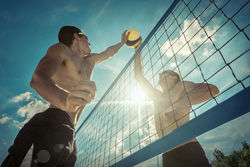 Overhead athletes such as tennis players, swimmers, cross fit athletes and volleyball athletes need to put their hands above their heads repeatedly for long period of times. Problems arise when the muscles that control the scapula get fatigued leading to injuries like shoulder instabilities, tendinopathies and impingements.
Overhead athletes such as tennis players, swimmers, cross fit athletes and volleyball athletes need to put their hands above their heads repeatedly for long period of times. Problems arise when the muscles that control the scapula get fatigued leading to injuries like shoulder instabilities, tendinopathies and impingements.
The predominant muscles that are involved in repetitive overhead motions such as required by a badminton player are the Serratus Anterior, Upper and Lower Trapezius.
A simple and great rehabilitative exercise with a kettlebell can be done to improve control and endurance in the Serratus Anterior and Upper Trapezius muscles.
- Start with a 6kgs Kettlebell and increase the weight as much as you need to be able to do three sets of 15-20 reps comfortably.
- Hold the kettlebell with a neutral wrist posture (no extension or flexion) with your thumb touching the chest.
- Press the kettlebell straight up and turn the arm out fully.
- At the top of the movement, actively reach the hand towards the ceiling as far as you can.
- Hold for a couple of seconds then slowly lower the weight back to the start position and repeat.
If you have any issues with your shoulder and are not sure what to do to resolve them then, we at In Touch Physiotherapy would be more than happy to look at it.
Happy lifting!





